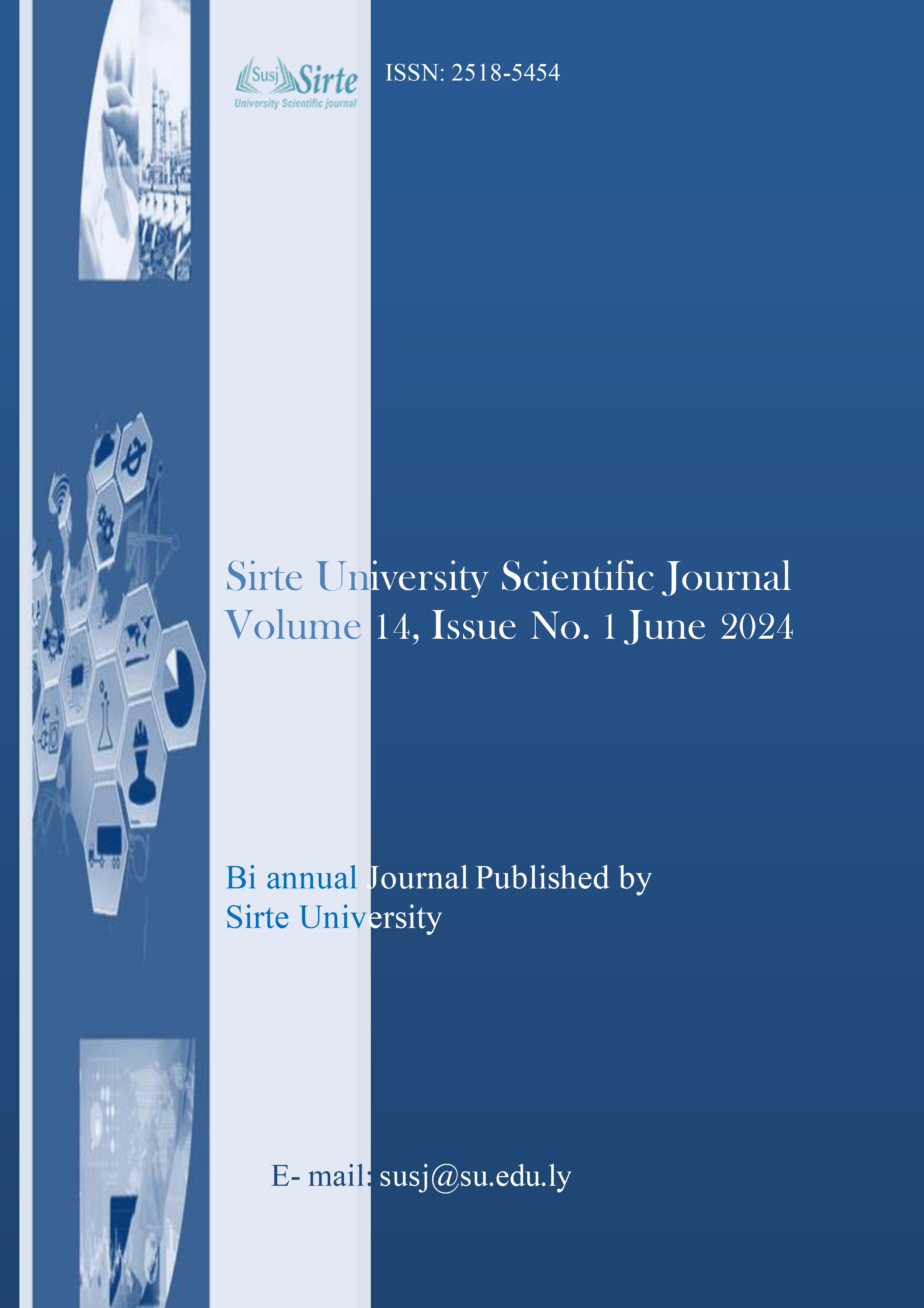Effect of Poultry Manure (litter) and Seagrass (Posidonia oceanic) Extract on Enhancing Pepper Plant Resistance to Cucumber Mosaic Virus (CMV)
DOI:
https://doi.org/10.37375/susj.v14i1.2794Keywords:
Poultry litter, Seagrass, Virus (CMV), Pepper plant resistanceAbstract
This study was conducted in the area of 27 East Sirte in 2022 to investigate the impact of different levels of poultry manure (poultry litter) extract (50 ml, 100 ml, 150 ml per irrigation process) and levels of Posidonia oceanic seagrass extract (50 ml, 100 ml, 150 ml) on enhancing resistance of pepper plants grown in pots to Cucumber Mosaic Virus (CMV). The results indicated a decrease in the severity of infection compared to the control. The infection rate in the control sample was 55%, while the lowest infection rate was observed with the treatment of 150 ml of poultry manure, showing a 13% infection rate. Seagrass extract treatments also demonstrated a significant impact on infection severity, with a decrease of 47%, 40%, and 36% for 50 ml, 100 ml, and 150 ml of seagrass extract, respectively. Overall, the addition of organic fertilizer to the soil led to improved resistance against CMV infection and stimulated growth in pepper plants. Application of organic fertilizer in agricultural soil is considered a practical method to mitigate the impact of climate change, improve plant productivity, and enhance disease tolerance for sustainable agriculture
References
Agrios,G,N,. (2005). Plant pathology, 5th edn. Academic Press, San Diego, p 803. https://doi.org/10.1017/s0014479700015507
Adhikary S (2012). Vermicompost, the story of organic gold: a review. Agric Sci 3:905–917. https://doi.org/10.4236/as.2012.37110
Arancon N, Cleave JV, Hamasaki R, Nagata K, Felts J (2020). The influence of vermicompost water extracts on growth of plants propagated by cuttings. J Plant Nutr 43:176–185. https://doi.org/10.1080/01904167.2019.1659355
Bisen K, Keswani C, Mishra S, Saxena A, Rakshit A, Singh HB (2015).Unrealized potential of seed biopriming for versatile agriculture. In nutrient use efficiency: from Basics to Advances (ed. Rakshit HB,Singh A), Springer India, pp 193-206. https://doi.org/10.1007/978-81-322-2169-2_13
Khattiyaphutthimet N, Chuasavathi T, Iwai CB (2020) Nutrient dynamicof vermicompost tea after adding molasses and oxygen. Inter J Environ Rural Dev 10:6–9
Keswani C, Mishra S, Sarma BK, Singh SP, Singh HB (2014). Unravelingthe efficient applications of secondary metabolites of various Trichoderma spp. Appl Microbiol Biotechnol 98:533–544. https://doi.org/10.1007/s00253-013-5344-5
Beth, J. (2005). Yard and Garden Line News. University of Minnesota Extension Service, Volume 7, Number 6.
Pottorff, L.P., (2004). Non-chemical Disease Control. Colorado State University Cooperative Extension plant pathologist and horticulturist, Integrated Pest Management Program, Jefferson County. 6/92. Reviewed 12/03.
Robert, N., David, J., Sanford, L. and James, C. S. (2001). Soil Management in Home Gardens and Landscapes. Information and Communication Technologies. College of Agriculture Sciences, Agriculture Research and Cooperative Extension, the Pennsylvania State University. pp.1-8.
Fegla, G.I. 1971. Some virus diseases affecting cucurbits in Ukrain. Ph.D thesis. Institute of Microbiology and Virology. Ukrainian Academy of Science. Kiev. USSR (in Russian).
Chung, E., C.M. Ryu, S.K. Oh, R.N. Kim, J.M. Park, H.S. Cho, S. Lee, J.S. Moon, S.H. Park and D.I. Choi. 2006. Suppression of pepper SGT1 and SKP1 causes severe retardation of plant growth and compromises basal resistance. Physiologia Plantarum, 126: 605-617. https://doi.org/10.1111/j.1399-3054.2006.00631.x
Laemmlen, F. 2004. Viruses in Peppers. University of California, Davis. 604 pp.
Lee, H.J., K.H Park, J.H. Shim, R.D. Park, Y.W. Kim, J.Y. Cho, H. Hwangbo, Y.C. Kim, G.S. Cha, H.B. Krishnan and K.Y Kim. 2005. Quantitative changes of plant defense enzymes in biocontrol of pepper (Capsicium annuum L.) late blight by antagonistic Bacillus subtilis HJ927. Journal of Microbiology and Biotechnology, 15: 1073-1079.
Zitter, T.A. and D. Florini. 1984. Virus diseases of pepper. Cornell University. Vegetable MD on line. Crops, Fact Sheet, Cornell University, New York State: 736 pp.
Saharan, B.S. and V. Nehra. (2011). Plant Growth Promoting Rhizobacteria: A Critical Review. Life Sciences and Medicine Research, 21:1-30.
Albrechtesn. S.E. (1997). Seed-borne viruses. (lecture notes) Danish Government Institute of Seed Pathology for Developing Countries. 34 pp.





